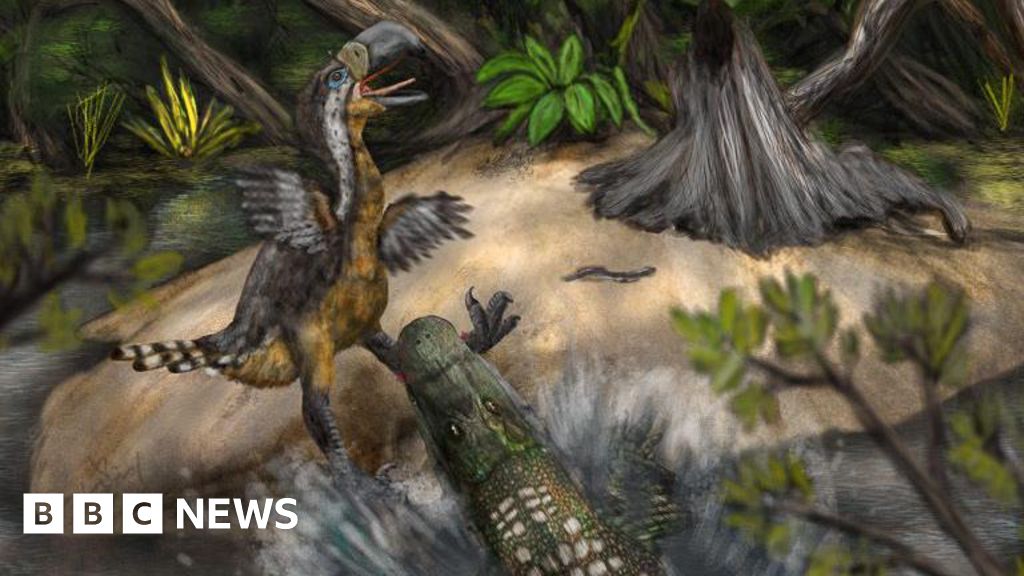【新闻摘要】
1300万年前的"恐怖鸟"死因终于破案了!哥伦比亚古生物学家通过3D扫描技术,在一根鸟类腿骨化石上发现了鳄鱼的齿痕,还原了一场史前"生死决斗"。这种身高2.5米、能用钩状喙撕碎猎物的顶级掠食者,居然栽在了鳄鱼亲戚——凯门鳄的嘴里。最搞笑的是,这块关键化石的发现者塞萨尔·佩尔多莫从小就在塔塔科阿沙漠捡骨头玩,如今他的私人博物馆竟成了破解古生物谜题的关键。科学家们说,这些没有愈合痕迹的咬痕证明:要么这只倒霉鸟当场毙命,要么就是死后被鳄鱼"加餐"。看来在史前沼泽里,再凶猛的"恐怖鸟"也逃不过"鳄鱼牌碎骨机"啊!
---
**Ancient 'terror bird' was killed by crocodile relative, bite marks reveal**
咬痕揭示古代"恐怖鸟"被鳄鱼近亲猎杀
**1 day ago Share Save Victoria Gill BBC Science Correspondent Share Save**
1天前 分享 保存 BBC科学记者维多利亚·吉尔 分享 保存
**Link et al/Biology Letters**
Link et al/Biology Letters
A 13-million-year-old leg bone from a giant"terror bird" bears teeth marks that suggest it was killed by an even larger reptile, scientists report. The fossil, discovered in Colombia's Tatacoa Desert, shows puncture wounds matching the teeth of prehistoric caimans - crocodilian predators that shared the bird's swampy habitat. Using 3D scans, researchers reconstructed what they believe was a fatal encounter between two apex predators of the Miocene epoch.
科学家报告称,一块1300万年前的巨型"恐怖鸟"腿骨化石上的齿痕表明它被更大的爬行动物猎杀。这块在哥伦比亚塔塔科阿沙漠发现的化石上的穿刺伤口,与史前凯门鳄的牙齿吻合——这种鳄目掠食者与恐怖鸟共享沼泽栖息地。研究人员通过3D扫描重建了他们认为是中新世时期两个顶级掠食者之间的致命遭遇。
Published in Biology Letters, the study compared the bite marks to museum specimens of crocodile-like predators. Lead author Dr Andres Link from Universidad de Los Andes said the unhealed wounds indicate the bird"either died during the attack or shortly after." Standing 2.5m tall with razor-sharp beaks, terror birds (phorusrhacids) dominated South America's food chain for over 50 million years until going extinct 1.8 million years ago.
发表在《生物学通讯》上的这项研究将咬痕与博物馆中类似鳄鱼的掠食者标本进行了比较。第一作者、来自洛斯安第斯大学的安德烈斯·林克博士表示,未愈合的伤口表明这只鸟"要么在袭击中死亡,要么不久后死亡"。恐怖鸟(恐鹤科)身高2.5米,拥有锋利的喙,统治南美食物链超过5000万年,直到180万年前灭绝。
**'Last day on Earth'**
"地球上的最后一天"
"The lack of bone healing tells us this was the terror bird's final moments," Dr Link explained."That day 13 million years ago was its last - then its leg bone waited to be found." The fossil was first unearthed 15 years ago by local collector César Perdomo, whose private museum has become crucial for paleontological research in the region. While terror birds were formidable hunters, the study suggests even they fell prey to giant caimans that could reach 6m in length.
"骨头缺乏愈合迹象告诉我们这是恐怖鸟的最后时刻,"林克博士解释道。"1300万年前的那一天是它的末日——然后它的腿骨等待着被发现。"这块化石最初由当地收藏家塞萨尔·佩尔多莫在15年前发现,他的私人博物馆已成为该地区古生物学研究的关键。虽然恐怖鸟是可怕的猎手,但研究表明它们也会成为体长可达6米的巨型凯门鳄的猎物。
**AFP**
法新社
**Rare predator-prey evidence**
罕见的掠食者-猎物证据
The Tatacoa Desert's Middle Miocene deposits (13-15 million years old) preserve a snapshot of an ancient wetland ecosystem."Finding direct evidence of interactions between top predators is extraordinarily rare," said co-author Dr Jorge Carrillo from the University of Zurich. The team digitally mapped 57 tooth impressions on the bone, matching them to caiman jaws in museum collections. Some punctures aligned perfectly with the spacing of teeth in Purussaurus - a massive extinct caiman species.
塔塔科阿沙漠的中新世中期沉积物(1300-1500万年前)保存了古代湿地生态系统的快照。"找到顶级掠食者之间相互作用的直接证据非常罕见,"合著者、苏黎世大学的豪尔赫·卡里略博士说。研究团队数字化绘制了骨头上57个牙齿印痕,将它们与博物馆收藏的凯门鳄颚骨匹配。一些穿刺与普鲁斯鳄(一种已灭绝的大型凯门鳄物种)牙齿间距完美吻合。
Dr Link noted the terror bird's injuries suggest a violent struggle:"The bite patterns imply the caiman clamped down with tremendous force, likely dragging its prey underwater." While unable to confirm if the attack was predatory or scavenging, the researchers say the bone's excellent preservation favors a sudden death scenario. This discovery adds to growing evidence that South America's prehistoric wetlands hosted intense competition between massive predators.
林克博士指出,恐怖鸟的伤势表明曾发生过激烈搏斗:"咬痕模式表明凯门鳄以巨大力量咬住猎物,可能将其拖入水下。"虽然无法确认这是捕食还是食腐行为,但研究人员表示骨头保存完好更倾向于突然死亡的场景。这一发现为越来越多的证据增添了新内容,表明南美史前湿地曾发生过巨型掠食者之间的激烈竞争。
**Next steps**
下一步
The team plans to scan more fossils from Mr Perdomo's collection, hoping to uncover additional predator interactions."Each bone tells a story," Dr Link said."We're just beginning to read this ancient ecosystem's violent history." Meanwhile, the terror bird's fossilized last stand will be displayed at Bogotá's Natural History Museum, offering visitors a glimpse into life - and death - in Miocene Colombia.
研究团队计划扫描佩尔多莫先生收藏的更多化石,希望发现更多掠食者相互作用的证据。"每块骨头都在讲述一个故事,"林克博士说。"我们才刚刚开始解读这个古老生态系统的暴力历史。"与此同时,恐怖鸟化石的最后姿态将在波哥大自然历史博物馆展出,让游客一窥哥伦比亚中新世时期的生命与死亡。

